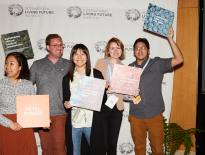Advocating for Affordable Housing: A New Tool
Editor’s Note: Join us for the Affordable Housing Summit on June 17th, 2021! This year we are focusing on the residents and will talk about working with communities to build housing that improves the quality of life for the residents and for the broader neighborhood. We will dig in on topics like inclusive community engagement, trauma-informed design, biophilic design, healthy materials, and how to finance it all.
Guide for Greener QAPS: ILFI Releases New Resource for Affordable Housing Advocates
The Living Building Challenge Affordable Housing Program includes a deep collaboration between the International Living Future Institute (ILFI or the Institute) and a leadership cohort of affordable housing developers and designers. The Institute is working to identify strategies to overcome social, regulatory, and financial barriers to providing equitable, healthy, and environmentally sustainable affordable housing.
Many affordable housing projects receive a significant portion of their funding through federal low-income housing tax credit (LIHTC) programs administered by state housing finance agencies (HFAs). Once or twice a year, state housing finance agency tax credit programs accept project applications and distribute awards. To aid in the selection process, HFAs create qualified allocation plans (QAPs), typically with lists of criteria and associated point values. These QAPs have a significant influence on the type of housing that gets built and can be used to incentivize certain building types and features. Many HFAs have found that adding sustainability criteria to their QAPs can be an effective method to encourage projects to consider health and energy efficiency.
Through its Affordable Housing Program and in partnership with many local partners, ILFI has spent three years working with HFAs around the country to incentivize sustainability and healthy materials in affordable housing projects through state QAPs. Where applicable, we focus on advocating for the integration of programs like the Living Building Challenge, Zero Energy Certification, Declare, and Enterprise Green Communities into HFA funding programs to ensure that affordable housing financing encourages energy efficient and healthy housing through the use of rigorous and accessible standards.
Over the course of this three year effort, the Institute established relationships with and advocated to eleven state HFAs and one district, as shown below.
ILFI Outreach, summarized by state or district: Alaska, California, Colorado, District of Columbia, Illinois, Kansas, Michigan, Missouri, Oregon, Pennsylvania, Texas, Washington
The Institute learned many lessons over the course of this outreach and advocacy effort, and decided to incorporate all of our lessons learned into a toolkit for our volunteers and other interested members of the Architecture / Engineering / Construction community that may be unfamiliar with how to get involved in the QAP process.The Guide for Greener QAPs. summarizes the partnership and advocacy process into eight steps, and illustrates how our network of volunteers can join with existing on-the-ground advocates in their own state to provide financial incentives for Living Affordable Housing. The eight steps are:
STEP 1: Read Through the Existing QAP
STEP 2: Make Contact
STEP 3: Establish Timeline + Gather Insight
STEP 4: Develop a Strategy
STEP 5: Tailor Language
STEP 6: Make the Case
STEP 7: Implement
STEP 8: Monitor Success + Review Updates
To read more about each step and to review case studies from around the country, download the Guide for Greener QAPs for free from the ILFI website.


